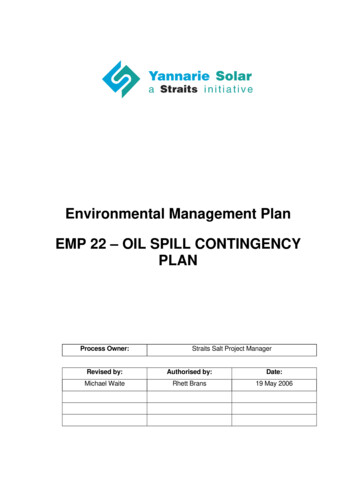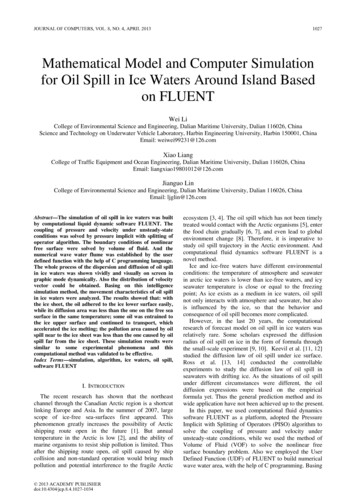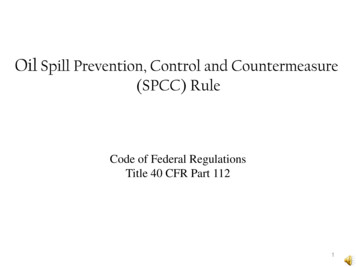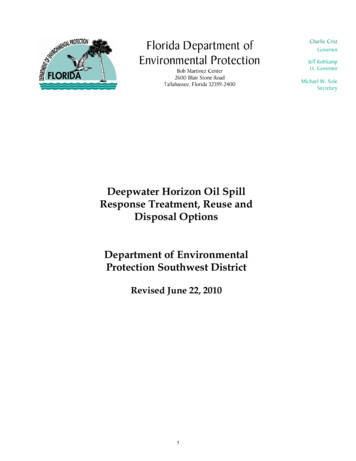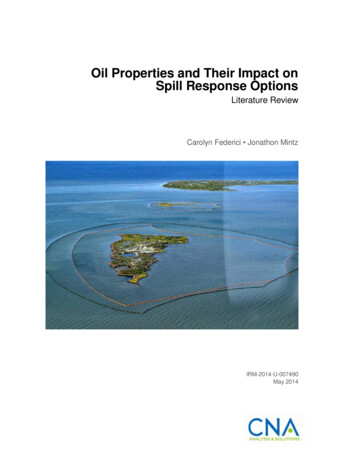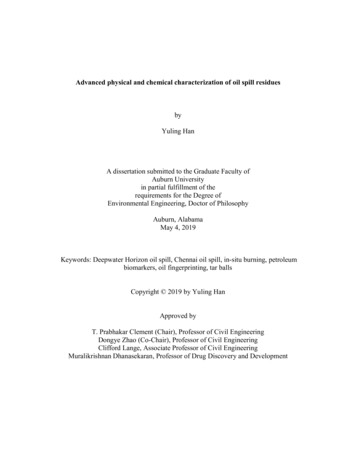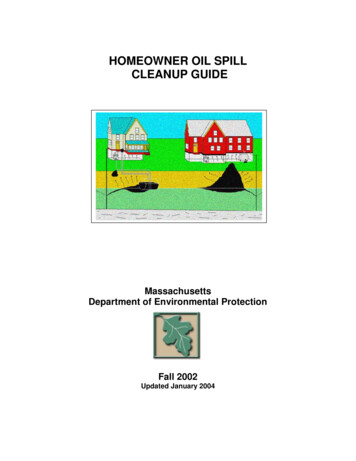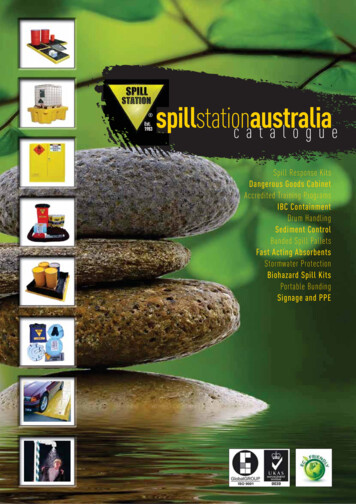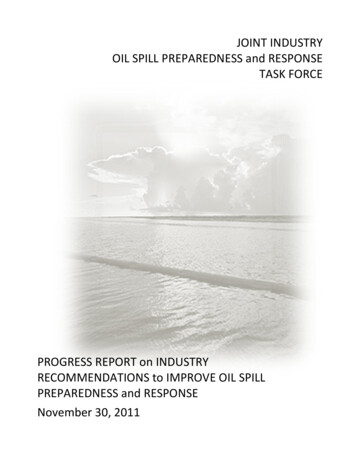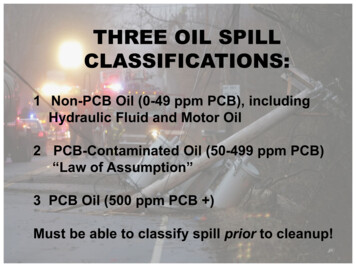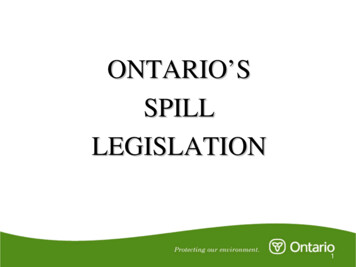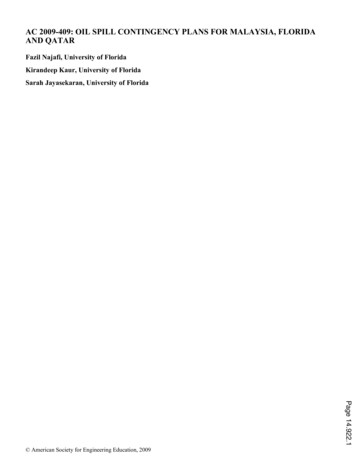
Transcription
AC 2009-409: OIL SPILL CONTINGENCY PLANS FOR MALAYSIA, FLORIDAAND QATARFazil Najafi, University of FloridaKirandeep Kaur, University of FloridaSarah Jayasekaran, University of FloridaPage 14.922.1 American Society for Engineering Education, 2009
OIL SPILL CONTINGENCY PLANSFOR MALAYSIA, FLORIDA AND QATARAbstractThe purpose of this research is to compare oil spill contingency plans of Malaysia, Florida andQatar. The idea behind the comparison is to identify best oil spill contingency plan practices toexpedite the removal of the spill. Furthermore, the three places are selected due to increased oiltankers traffic. Oil spill is the release of a liquid petroleum hydrocarbon into the environment dueto human activity mainly into the ocean or coastal waters. Oil may be a variety of materials,including crude oil, refined petroleum products or by-products, oily refuse or oil mixed in waste.Spills take months or even years to clean up.Most human-made oil pollution comes from land-based activity, but public attention andregulation has tended to focus most sharply on seagoing oil tankers. Malaysia, Florida and Qatarhave unique needs and requirements for responding to oil spills, and all have basic needs for anoil spill contingency plan. The Straits of Malacca which stretches for 575.4 miles is situatedbetween Peninsular Malaysia and the Island of Sumatra, Indonesia. The Straits is at its widest inthe northern entrance which is almost 253.176 miles and at its narrowest point of barely 9.2064miles at the southern end. The Straits of Malacca is recognized world-wide as one of the busiestwaterway in the world. It is strategically located for movements of vessels to the east and west ofthe globe. On average about 200 vessels of various types ply the route daily.The Malaysia and Qatar oil spill contingency plans area have tiered response system, whichdefines a clear responsibility and authority for any tier in the tiered response. Of late the Straitsof Malacca is facing an increasing threat of serious oil pollution from ships. Oil is beingdeliberately discharged or spilled as a result of collision. A few major incidents have occurredover the last 20 years in the Straits of Malacca. Florida and Qatar has a diverse coastalenvironment that is important not only for their ecosystem but for the revenue it generates fromtourism and fishing. Florida’s response system is a network-based operation controlled by countyor city officials, depending on the degree of spill, location and the available resource. Growingtanker traffic in Florida waters, shortage of cleanup equipment, types of currents, shallow reefs,and vulnerable coastline all contribute to greater potential damage from an oil spill. Qataroccupies the small Qatar Peninsula on the northeasterly coast of the larger Arabian Peninsula. Itis bordered by Saudi Arabia to the south and is oil rich nation.The National Oil and Hazardous Substances Pollution Contingency Plan, commonly called theNational Contingency Plan is the United States federal government's blueprint for responding toboth oil spills and hazardous substance releases. The oil spill contingency for Malaysia, Floridaand Qatar work well, however Florida response system has some advantages like oil spillinformation database which enables quicker response. The systems need to enhance theircoordination between the parties involved in cleanup and mitigation.Page 14.922.2
IntroductionSpurred by the impact of the 1989 Exxon Valdez oil spill, the United States in 1990 enacted theOil Pollution Act (OPA 90). In the same year, the 1990 International Convention for Oil SpillPreparedness, Response and Cooperation was enacted into force, and many of the conventionsignatories set about reforming and revising their own oil spill status1. During the early 1990s,new or revised oil spill regulation emerged in many countries around the world.With the development of new regulations and improved spill response regimes, the internationalregulatory framework for oil spill prevention and response has grown more elaborate.Prince William Sound Tanker Spill Prevention and Response PlanTankers transiting Prince William Sound are required by the state to have oil spill contingencyplans. The Prince William Sound Tanker Oil Discharge Prevention and Contingency Plan is arequired part of each tanker's individual contingency plans. APSC/SERVS is the PrimaryResponse Action Contractor responsible for the implementation aspects of the PWS Tanker CPlan. The prevention portion of this plan requires that each laden tanker transiting PrinceWilliam Sound must be escorted by two vessels, one of which must be a specially equippedprevention and response vessel or tug. Laden tankers are tethered to Escort Tugs from theTerminal through the Valdez Narrows and Valdez Arm. Also included in the plan are speedlimits for tankers and weather restrictions. The Response portion of the plan includes plans foropen-water, near shore and shoreline responses and support operations.Companies that store, produce, handle, or transport oil and other hazardous substances mustcomply with these myriad requirements, many of which mandate the development ofcontingency plans. Oil spill contingency plans serve two broad purposes: demonstratingcompliance with applicable regulations and providing essential information that can be applied toany oil spill quickly during response activities. Oil spill contingency planning occurs in bothpublic and private sectors. A public contingency plan is developed by government agencies orministries, often with industry and public involvement. It may include the following:1 information of state-owned equipment stockpiles; local or regional logistical considerations; and Natural resource information including sensitive environmental areas.This paper addresses three systems of oil spill contingency plans and responses.The Malaysia Oil Spill Response SystemMalaysia is a maritime country, which adopted its National Oil Spill Contingency Plan (NOSCP)in early 1970. In line with established international practice, Malaysia has enacted a three-tierapproach to all aspects of oil spill preparation and response, which defines the party responsiblefor oil spill cleanup according to different degrees of oil spill.Page 14.922.3The Straits of Malacca which stretches for 500 nautical miles is situated between PeninsularMalaysia and the Island of Sumatra, Indonesia. The Straits is at its widest in the northern
entrance which is almost 220 nautical miles and at its narrowest point of barely 8 nautical milesat the southern end. The Straits of Malacca is recognized world-wide as one of the busiestwaterway in the world. It is strategically located for movements of vessels to the east and west ofthe globe. On average about 200 vessels of various types ply the route daily. These include thevery large crude containers of VLCCs, other merchant ships, warships and fishing vessels. Withsuch number of vessels going up and down the straits, it has been very fortunate that the numberof accidents is not high. Since 1977 only about 70 marine accidents were reported in the MalaccaStraits.Tier 1Tier 1 is site-specific. It includes most shore-side industries with oil transfer sites, offshoreinstallations, and vessels that are required to have a shipboard oil pollution emergency plan. Itcovers small oil spills and oil spillage occurring within specific facilities. Cleanup responsibilityis taken by local authorities or local oil companies2.Tier 2Tier 2 is provided by Regional Councils and unitary authorities acting as Regional Councils.These agencies are responsible for providing an operational response to oil spill incidents withintheir regions out to a 12-nautical mile limit of Territorial Sea. Under such conditions, this typeof oil spill exceeds the capability of Tier 1 and no responsible party can be identified. TheDepartment of Environment will offer adequate resources to Regional Councils to ensuresufficient equipment and personnel available for them to undertake this role. Regional Councilsalso have responsibility for ensuring that industries with oil transfer sites within their regionproduce appropriate oil spill contingency plans. An Area Operation Committee (AOC) will beformed to coordinate this Regional Oil Spill Combat Operation, and it is chaired by an officerappointed by the Director General of Environment2.Tier 3Tier 3 is the responsibility of the Malaysia Department of Environment (DOE). The MalaysiaDOE manages the National Oil Spill Contingency Plan. When a spill occurs within a region thatis beyond the resources of the region, the DOE will assume responsibility for managing the spillresponse. Malaysia purchases and maintains oil spill response equipment, which will allows it tocontain and clean up a spill up to 25,000 tons of persistent oil. If a large oil spill is beyondMalaysia’s own resources, the DOE will seek and coordinate an international response2. Figure1 shows the three-tiered approach to Malaysia’s national oil spill contingency plan1.Spill Notification and ReportingPage 14.922.4When a spill occurs, it must be reported to local DOE officers or the Marine Department officenearest to the incident site. The report should have the following information2: location of incident; type and size of spill(s); date and time of incident; and
Other relevant information.Cleanup ResponsibilityIndustries that are responsible for oil spills must take immediate action to contain the spill andquickly start the cleanup operations. When a spill occurs, an area co-coordinator (AC) isappointed by Malaysia’s Harbor Master of the Assistant Port Officer who carries out a promptinvestigation of the oil spill incident and forwards the investigation report to the Director ofEnvironment. After notifying the Regional Council or the Department of Environment, thecompany actuates the local/industry Tier 1 contingency plan. If the person in charge assesses thescope as beyond their capability and seeks support, the regional on-scene commander (ROSC)appointed by DOE or the Regional Council will take over the cleanup responsibility from theindustry on-scene commander (OSC). The response then progresses to Tier 2. If a spill responsewithin a region is beyond the capability or resources at the disposal of ROSC, the DOE is to benotified, and the responsibility for response is escalated to Tier 3. At this stage, the DirectorGeneral of Environment appoints a national on-scene commander (NOSC), and the NOSC willassume control of the response. For a large spill, if the spill has the potential of reaching ashoreline, a shore cleanup coordinator (SCC) will be appointed2.Cleanup StrategiesAll OSCs are allowed to take whatever actions are appropriate to clean up and/or mitigate theeffects of an oil spill. In general, these actions fall into three main areas2.Monitor the PollutionUnder certain circumstances, it may be inappropriate to contain or clean up a spill. The best andmost cost-effective response may be to monitor its progress and leave the oil spill for the weatherto disperse naturally2.Response at SeaDealing with oil while it is still afloat in the sea is always preferable to allowing the oil to float orwash ashore. The OSC’s first priority is to protect the sensitive coastal environment from spilledoil by containing and cleaning the spill while it is in the sea before it reaches coasts andshorelines. The major cleanup options at sea are2: containment and recovery using booms and skimmers; solidification by Biodegradable Oil Interceptor (BOI) treatment; use of chemical dispersant; use of absorbent (only those approved by DOE); and In-situ burning.Shoreline ResponsePage 14.922.5When oil has stranded on the shore, the environmental impact and cost of cleaning is often muchgreater than if the oil were dealt with at sea. The most used methods are2:
pre-cleaning – areas are cleaned of debris in advance to make for easier access and tolessen the quantities of oily waste; mechanical and labor – machines and personnel are utilized for intensive shorelinecleanup; leaving the cleanup to natural processes; and Bioremediation – living organisms are used to break down the oily waste. The SCC will decide which method of cleanup to follow based on the specific circumstances.The SCC must also decide cleanup priorities of different locations on the shoreline2.Waste DisposalAll waste should be disposed of in an environmentally sensitive manner. Rules and regulationsunder the Environmental Quality Act of 1974 (Amendment 1996), governing waste should befollowed. It is the responsibility of the OSC to determine and carry out the disposal recovery ofall oil waste2.Malaysia Information Management System for Oil SpillsThe Department of Environment establishes and maintains a national oil spill database. All oilspill incidents are recorded on this database using information provided by the Regional Counciland other reporting agencies. At the conclusion of clean-up operations for minor spills andresponses, and as soon as possible during a major spill, the regional or national OSC must sendthe DOE a full report of the spill and response. The DOE will provide Regional Councils withappropriate oil spill reporting forms for recording. The DOE also maintains and updates aresource database as part of the National Oil Spill Contingency Plan2.Page 14.922.6
Oil spillFIRST TIERLocal ResponseIs the response of oil spill fromport areas or local oil industry?NoYesEquipment and manpowercapability?NoYesActivate local oil spill contingency planHas the spill spread beyondlocal area?NoYesSECOND TIERArea ResponseEquipment and manpowercapability?NoYesActivate Operation Committee or Straits ofMalacca contingency planHas the spill spread toneighboring countries?NoYesTHIRD TIERRegional ResponseActivate National Oil Spill Contingency PlanFIGURE 1 Malaysia tiered oil spill response system.Page 14.922.7Implement
Florida Oil Spill Response SystemFlorida has a unique shoreline, which is important for both her fishing and tourist Industries.The Florida oil spill response system6 (Figure 4) follows a plan enacted by the Florida legislatureto support the Region IV Contingency Plan. This system can provide a computerized database toexpedite the oil response and enhance the existing response capability The largest spill occurredon September 16, 1969 when approximately 189,000 gallons of #2 fuel oil spilled when thebarge Florida, which ran aground off West Falmouth. In recent years, improvements tonavigation and more rigorous pilotage requirements are believed to be minimizing risks of futurespills in Buzzards Bay. Nonetheless, smaller spills from barge and vessel groundings in the Bayhave continued during the 1980s and 1990s. Other notable groundings in Buzzards Bay includethe grounding of the Bermuda Star off Cleveland Ledge in 1990, releasing 7,500 gallons of No. 6fuel. There was also a 50 gallon spill from an empty fuel tank when the QEII grounded off Sowand Pigs Reef near Cuttyhunk in 1992. A January 1996 grounding of the barge North Cape offMoonstone Beach in Rhode Island releasing 880,000 gallons of Number 2 fuel raised concernsof local officials about oil preparedness.Response CategoryTo ensure an effective oil spill response, the Federal Response Organization established anational response center (NRC), a national response team (NRT), regional response teams(RRT), and on-scene coordinators (OSC). If an oil spill is large enough to be beyond the controlof the RRT, the NRT can be actuated. The NRT may monitor the spill (evaluating the report ofthe OSC); request oil spill responses from federal, state, local, or private organizations; andcoordinate other activities as may be required to ensure an oil spill response operation iseffective3.Page 14.922.8
MartinCharlotteLeePalm BeachBoca RatonBrowardCollierCape Romano3MonroeSoldier Key4Dade1Biscayne BayShell KeySensitiveShorelines21 - Cape Romano - Shell Key2 - Florida Keys & Reef Tract3 - Key Biscayne - Boca Raton4 - Biscayne BayFIGURE 2 Sensitive shorelines in Florida.Page 14.922.9
FIGURE 3 Assumed spill locations, cleanup contractors, and expected travel time for cleanupcontractors.Procedure and OrganizationState OSCs are pre-designated federal officials from the U.S. Coast Guard (USCG) or theEnvironmental Protection Agency (EPA). OSCs collect facts about a spill, identify the potentialimpact of the spill, and estimate cleanup costs. They hire commercial contractors identifiedthrough a database for cleanup and monitor activities. If commercial resources are not available,the OSC can deploy federal resources, personnel, and equipment obtained from the NationalStrike Force and the U.S. Navy. The main tasks that must be implemented by the OSC are asfollows3:Ø immediately notify the RRT and NRC of spill conditions;Ø classify the size of the discharge and determine the proper course of action; andØ Determine the state or local government cleanup capabilities to carry out theresponse.Page 14.922.10The response to oil spills in Florida is based on a methodology of gathering information from oilcleanup contractors, cooperatives, equipment manufacturers, the Marine Spill Response
Corporation (MSRC), Florida port authorities, the Department of Natural Resources (DNR), theEPA, and the USCG1. Once an oil spill occurs, current information is immediately available toauthority. The contingency plan is operated by an oil spill task force composed of individualstrained in oil spill response methods. The OSC is ultimately responsible for coordinating thecleanup activities and monitoring of the oil spill. Florida’s state response team (SRT) is aided bythe following groups4: Department of Natural Resources; Department of Environmental Regulation (DER); Department of Community Affairs; Department of Commerce; Department of Highway Safety and Motor Vehicles; Department of Law Enforcement; Department of Legal Affair; Department of Transportation; Game and Fresh Water Fish Commission; Governor’s Offices; and Department of Health and Rehabilitation Services.The SRT chairperson is either the executive director of the DNR or the secretary of DNR. Thechairperson is responsible for the overall management of SRT and its consortium of availableresources5,6.Florida Oil Spill Response Information System: Computerized DatabaseThe database is maintained and updated by the SRT, and is also used by different industry andgovernment agencies to update inventory of equipment and oil spill cleanup activities. Itincludes the following information4: oil-sensitive areas in Florida – areas of sensitive shorelines are identified as reportedby the state ( Figure 2); oil spill response team – lists addresses and phone numbers of oil spill responseagencies: RRTs, SRTs, counties and cities; and Cleanup organizations and equipment: provides information on oil spill responseorganizations and equipment available in Florida.The advantage of this system is that relevant industries can use the program to update theirequipment inventory and necessary response times. The Florida spill SRT is responsible forkeeping the database up-to-date and disseminating the information to relevant agencies, cities,counties, and industries. Under this system, when an oil spill occurs, it ensures the relevant partymay have information available to respond instantly.South FloridaOil Spill ResponseInformation SystemPage 14.922.11Data Base Flow Chart
FIGURE 4 Florida oil response information system.Page 14.922.12Qatar Contingency Plan
Qatar is sitting on the world's largest natural gas fields and some larger oil fields and is one ofthe world's richest countries. System is a central control operation, with primary authority andcontrol of any oil spill response assumed by the Qatar General Petroleum Corporation (QGPC).Local industries are expected to protect their own facilities, but QGPC also responds to thosespills that threaten public and government coasts and the Persian Gulf ecosystem.Qatar’s contingency plan for oil spill cleanup is designed expressly in a broad framework, alongwhich lines detailed action plans can be developed to meet various situations. The QGPCassumes primary authority of operations control for the oil spill response efforts. Thecorporation’s philosophy is to clean up spills originating from its activities and to do everythingpossible, utilizing its own resources, to prevent any pollution from spreading. The corporationholds material and equipment stock levels based on results of its investigation into maximumpossible size of any spill which could reasonably be expected to occur in any one of the oil fieldsor other offshore facilities. Its basic contingency plan is to develop an oil combating unit when alarge spill occurs, defined as a spill beyond the in house capabilities of the corporation. The unit,as will be described, will develop into a complete, in place structure of personnel, equipment andresources that will facilitate the cleanup activities. As the need arises, this in place organization,knowledgeable of available local resources, is prepared to locate and employ outside help.In the United Arab states it is understood that local industries will protect their own facilities.But if required, the corporation will protect their own facilities. But required, the corporation willloan its available equipment along the following parameters of priority4:Ø Power station/desolationØ The umm said complexØ West bay cornice and amenity facilities in Doha bayArea of responsibilityThe corporation has a much defined area of responsibility for any oil pollution originating fromits own operating areas and along a specifically designated corridor on Qatar’s east coast. Its oilspill combat will concentrate mainly on the dispersing, containment and recovery of sea bone oilin addition to efforts aimed at preventing spilled oil from entering power and desalination plants,industrial complexes, and important amenity beaches along Qatar’s east cost4.Spill reporting procedure:Page 14.922.13Oil spillages must be reported as quickly as possible to the marine superintendent with thefollowing details:Ø Location of spillØ Approximate dimension oil spillØ Type of oil (light, dark thick, etc)Ø SourceThe marine superintendent will assess the situation from information available and will, inconsultation with the operation manager, decide on what type of action is to be taken. In case ofsmall spill the marine superintendent will decide whether or not cleanup action has to be taken.In case of medium spill, it can be handled without external help. Whereas in case of large spills it
may require assistance from large Arab state members. In the instance of large spill, the marinesuperintendent will appoint an Oil Spill Response Committee consisting of4:Ø A management representative to determine the policy required and initiate contact withother action groups and relevant government agencies without the country.Ø An advisor on environmental mattersØ An advisor on equipment and its uses. He should come from a reputable contractor, bethoroughly familiar with operating a wide range of anti pollution equipment and will giveadvice on the deployment and maintenance of equipment. He will be required to makevisits to the site of the pollution to give guidance in the handling of equipment and on themethods of the oil containment and pickup.Ø An on scene commander (OSC), to be nominated from within the corporation. He willmanage the operation on the site, and has the authority to commit manpower and financesto the response team.Ø One surveillance member to make routine helicopter flights to site to compile maps andorganize reports of the movement of oil from vesselsØ Two members at department head level to provide the necessary commitment to thecontingency plan and emergency procedures.Ø One safety/fire member to administer the safety aspects of personnel and equipmentworking in a hazardous environment.Ø One head of department dealing with the source of pollution to keep the committee fullyinformed on the steps taken to curb the flow of oil and all related matters.The oil spill response committee may request services of the legal advisor and the head of thepublic relations department. The committee is responsible for the development and maintenanceof the contingency plan and procedures.Combat sectionThe combat section has two sections leaders, leader the onshore and the offshore leader. Theseleaders are familiar with the equipment available in the corporation and equipment availablefrom other members. They also have limited authority over expenditures necessary for theefficient operation of their respective sections. If suitable personnel cannot be found or releasedfrom within the corporation, a contractors’ personnel with be employed by leaders. A long termcontract is maintained with a contractor in the gulf area to provide a pool of labor capable ofbeing used in connection with the corporation’s pollution equipment. The onshore leader andOSC maintain a list of available approved contractors and equipment.Cleanup CapabilitiesThe capability for efficient oil spill cleanup depends on the resources that can be supplied by thecleanup organizations, contractors, or cooperatives. The most important resources are equipmentand personnel. Performance of the equipment operators is also important, as are their quantityand capacities in determining the effectiveness of a response in operation.Page 14.922.14Skimmers are used to recover the oil contain by the booms (booms are placed around the spill tocontain it, which helps thicken the oil for skimmer removal). Skimmer performance is affected
by oil viscosity and often by the physical properties of oil. Different skimmer systems havevarying oil recovery capacities. But usually the capacity of a certain skimmer decreases once theoil becomes emulsified cooler weather and colder water temperature speed emulsification.According to oil spill contractors, during winter months a quick containment and recoveryresponse, before emulsification of the oil can take place, is essential. For milder conditions andwarmer water temperatures, emulsification begins 14 to 16 hours after the spill. So the time lapsebetween the occurrence of the spill and the start of the cleanup is another factor affecting thesuccess of a cleanup operation4.Advantages and disadvantages of oil spill response Systems of Florida, Malaysia and Qatar1. Method of ApproachMalaysia has clearly defined responsibilities and authorities in its three-tiered system. Thespecific advantage of the Florida system over the Qatar system is in the oil spill responseinformation system database, which includes information on oil sensitive shorelines, responseteams, disposal sites, cleanup organizations, and equipment.2. EquipmentThe basic cleanup equipment in Malaysia is allocated to each regional council by the DOE. Thecapacity of the equipment stockpile will enable Malaysia to cope with spills of up to 25,000 tonsof persistent oil. The DOE will require international support if the oil spill exceeds theircapability. This is ensured by an international agreement between the regional countries ofSingapore, Indonesia and Brunei. Malaysia’s Information Management System (MIMS) for oilspills can assist the AC in making a decision at the scene of an accident. While their system isnot as dynamic as the system of Florida, MIMS does not include recovery equipment locationsand response times.The Qatar response system also has a quantity of equipment available for oil spill cleanup.However, the certainty of the exact status of availability is lesser defined. There is no primaryinventory record of equipment available in the country, other than the inventory of thecorporation, which is in itself static since it was established on the basis of one analysis of theanticipated needs in the case of a spill. It is not dynamic like that of Florida, which provides thecapability of the contractors to adjust inventory levels as they identify need changes through thedata base. The equipment information is known, but only unofficially, through the contacts ofpeople within the separate organizations of the country. When a response to a large oil spillcleanup is indicated, it must form the oil spill response committee, on which a key person is theOn Scene commander. He will be picked partially for the requirement that he has extensive localcontacts. Before he can mobilize oil spill containment efforts, he must make efforts to determinewho has what equipment and where it is. QGPC does not have network of other organization topool resources as does Florida , the corporation does have access to resources of Qatarenvironmental protection committee, which also has access to other local resources, but thisstructure is less defined as that of Florida’s support structure.Page 14.922.15
3. PersonnelThe Malaysia oil spill response team is directly controlled by an area coordinator who isappointed by the Harbor Master of the Assistant Port Officer, who coordinates with the OSC andSCC for any major oil spill. The OSC will control the offshore cleanup and the SCC will controlthe onshore cleanup. The AC coordinates with the OSC and SCC. When a spill occurs, the ACis called in to investigate the accident and forward the investigation report to the DOEimmediately. The AC will take precautionary measures to control the spill by mobilizingexisting equipment promptly. Under this organization, the AC must be familiar with the localresponse team and the availability of resources.The OSC of QGPC must first establish preliminary contacts to determine the personnel thatmight be available to their oil spill cleanup efforts. This was another reason for requiring him tobe familiar with local conditions, he knows where he can go to find personal availability andthen arrangement must be
Oil may be a variet y of materials, including crude oil, refined petroleum products or by-products, oily refuse or oil m ixed in waste. . for oil spill cleanup according to different degrees of oil spill. The Straits of Malacca which stretches for 500 nautical miles is situated be tween Peninsular
